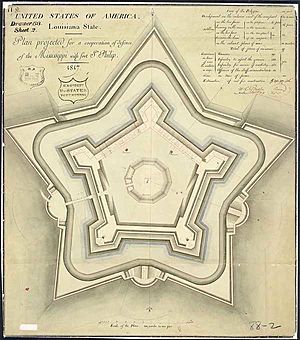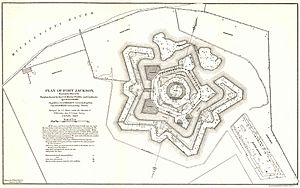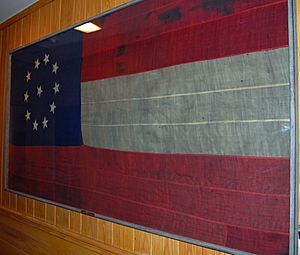Fort Jackson, Louisiana facts for kids
|
Fort Jackson
|
|
 |
|
| Location | Plaquemines Parish, Louisiana, USA |
|---|---|
| Nearest city | Triumph, Louisiana |
| Built | 1822–32 |
| NRHP reference No. | 66000379 |
Quick facts for kids Significant dates |
|
| Added to NRHP | October 15, 1966 |
| Designated NHL | December 19, 1960 |
Fort Jackson is a historic fort made of stone. It is located about 40 miles (64 km) up the Mississippi River from the ocean. This fort is in Plaquemines Parish, Louisiana. It was built to defend New Orleans between 1822 and 1832.
The fort was a key battle site during the American Civil War. Today, it is a National Historic Landmark. Strong storms like Hurricane Katrina and Hurricane Rita have damaged it. Its condition is now at risk.
Fort Jackson is about 70 miles (113 km) south of New Orleans. It sits on the western bank of the Mississippi River. The older Fort St. Philip is across the river on the eastern bank. Fort Jackson was built after the War of 1812. It was named after Andrew Jackson, who suggested building it.
The fort was used by the military for many years. It served different purposes from when it was finished until after World War I. Then, it became a training station. Now, it is a National Historic Landmark and a history museum. Plaquemines Parish owns and runs it.
The Civil War Battle
Fort Jackson was the site of a big battle during the American Civil War. This battle was called the Battle of Forts Jackson and St. Philip. It happened from April 16 to April 28, 1862. The fort was controlled by the Confederate army.
A fleet of U.S. Navy ships attacked the fort. Their leader was Flag Officer David Farragut. The ships attacked for 12 days. On April 28, the Union fleet sailed past the fort's guns. The fort then fell to the Union forces. Some soldiers inside the fort decided to stop fighting. After this, Union forces went on to capture New Orleans.
After the battle, Fort Jackson was used as a prison by the Union. A famous French businessman, Charles Heidsieck, was held there. He was accused of spying and stayed for seven months.
Fort Jackson Today
On November 9, 1927, the state of Louisiana sold Fort Jackson. Mr. and Mrs. H. J. Harvey bought it. They later gave the property to the parish in 1960. They hoped the fort and its 82 acres of land would be fixed up.
The fort was named a National Historic Landmark in 1960. It was also added to the National Register of Historic Places in 1967. Plaquemines Parish started fixing up the fort in 1961. The National Park Service said the fort area was like a "jungle." Tunnels were full of mud and water, and snakes lived there.
Today, the fort grounds are open as a park for visitors. Sometimes, the inside of the fort is also open to the public. The Fort Jackson Museum is not at the fort itself. It is about 1 mile (1.6 km) southwest of the fort. You can find it at 38039 Hwy 23, Buras, LA 70041.
Facing the Storms
Fort Jackson is in a place where it often gets hit by strong storms. These storms bring powerful winds, heavy rain, and huge storm surges. A storm surge is a wall of ocean water pushed onto land.
The fort was flooded with 20 feet (6 meters) of water in September 1965. This was from Hurricane Betsy, a very strong storm. It was flooded again in August 1969 by Hurricane Camille, another powerful storm.
In 2005, Hurricane Katrina caused a lot of damage with its storm surge. After Katrina and Hurricane Rita the next month, much of the fort was underwater for up to six weeks. Many historical items inside the fort were ruined. The fort itself also suffered damage to its structure.
Other Cool Uses
Since 1970, the grounds of Fort Jackson have hosted local events. These include the Plaquemines Parish Fair and Orange Festival.
The fort was also used to help birds covered in oil. This happened during the Deepwater Horizon oil spill in 2010. The bird treatment center later moved to Hammond, Louisiana. This move made it safer from hurricanes.
See also
 In Spanish: Fort Jackson (Luisiana) para niños
In Spanish: Fort Jackson (Luisiana) para niños






